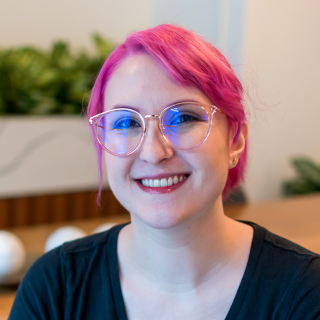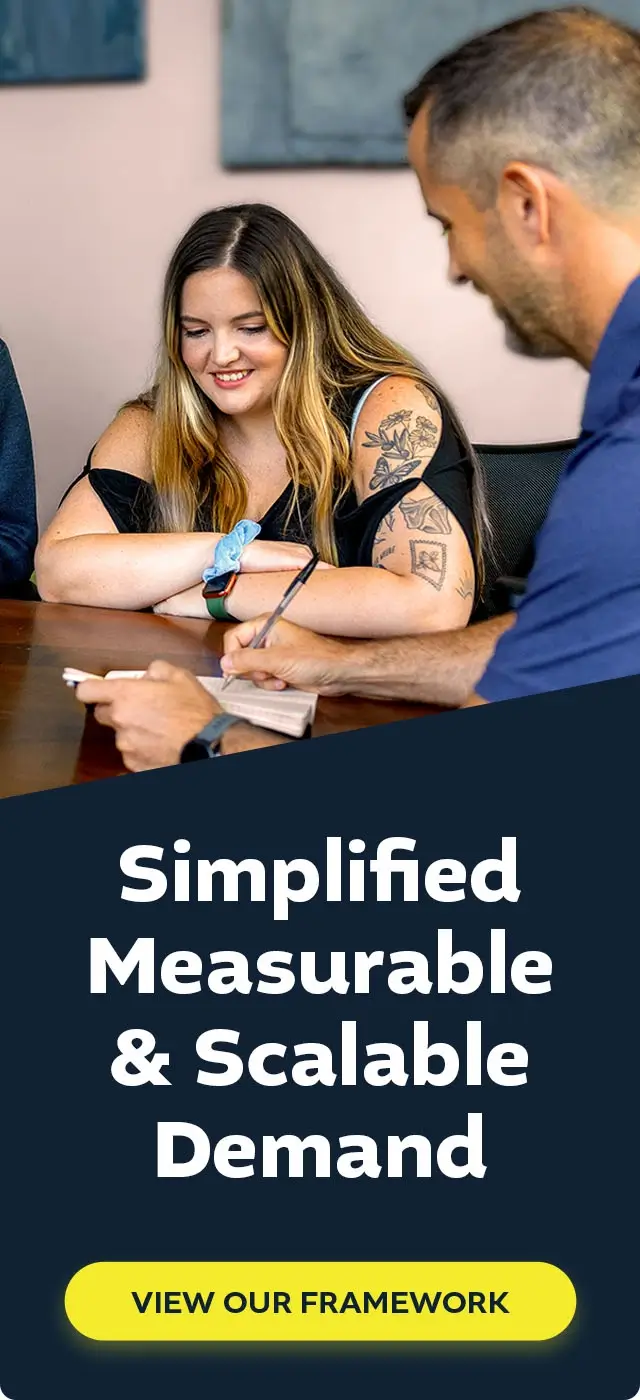At OM, we apply a three-step approach to our inbound digital marketing strategies for each and every client.
The first step in this process is building a proper foundation for our client based upon the principles of conversion rate optimization. At the same time, we install and set up analytics software with event-based tracking and conduct an SEO analysis of the account. Once this is complete, we can move on to steps 2: Demand Generation and 3: Optimization.
1. Conversion Rate Optimization
Conversion Rate Optimization (CRO) is the process of designing a website that is best suited to driving conversions, whether that’s a purchase, a lead, or an event signup. For our methods, we implement clear funnels, calls to action, dynamic landing pages tailored to the messaging of their funnels, and consistent optimization. By keeping in line with these best practices, OM consistently designs websites that outperform their previous numbers.
Show Them Where to Go
Providing a clear, easy-to-understand funnel for potential leads to follow is key to optimizing your site for conversions. Your messaging should be consistent throughout all channels from the first touch to the final email. This means keeping CTAs, ad copy, the desired action, page copy, nurture emails, sales outreach, and more in line with one consistent message.
Show Them What to Do
If you haven’t noticed already, we’re pretty gung-ho about clarity in CRO. Your Calls to Action are no exception. Stay in line with the messaging for the rest of your funnel, and don’t trick your users, whether it’s intentional or not. Don’t have a CTA to start a trial then require them to schedule a demo.

Give Them a Place to Convert
Having an organized and uncluttered landing page is one of the most important parts of CRO. You can convert
on your home page, sure, but having a landing page specifically designed to drive conversions will
outperform your home page nearly every time. There are several approaches to landing pages that have
different benefits for different industries. We highly recommend testing dynamic landing pages through
code. Using UTMs, you can implement copy that’s highly specific to several different campaigns or
audiences using just one landing page. We’ll talk more about this another time.
Get Them to the Goal
The ultimate goal of CRO is to turn your website into a lead (or purchase) machine. You want to drive a
higher ratio of conversions to traffic. Make sure that anyone who gets to your website can easily get to
the end goal. Have a CTA for every intent and traffic source. Put CTAs on your blog posts, add them to
your header and your footer – add them anywhere it makes sense, especially if they’re not going straight
to a landing page. Blog posts should have CTAs that tie to your messaging. Here’s one now 😉
2. Analytics
Implementing proper analytics software is often the most complicated, but also the most important part of your foundation.
There are several tools you can use depending on your unique situation. As an agency, we prefer to use Google Tag Manager to manage all of our analytics. Once GTM is added to your code, you can do so much within GTM without having to bother your developer. With GTM we add our Analytics tracking code, our Facebook pixel, our LinkedIn pixel, and more. You can even set up event tracking within GTM.
We would have to create an entire series to talk about everything GTM can do. It has its limitations, but you can handle nearly every part of your analytics within it, so we can’t recommend it enough.
Touching on event-based tracking; that is our bread and butter here at OM. You can implement destination-based conversion tracking, but we’ve all seen one conversion come in as 2, 4, even 12 – so we avoid it whenever possible. Event-based tracking essentially only allows one conversion per event, regardless of how many times someone has refreshed their confirmation page.
Once you’ve set up your event-based tracking in GTM, it’s important you go into each of your tracking programs and make sure to input that information as a conversion to make the data more meaningful and easier to parse.
3. Search Engine Optimization
Another equally important component of your foundation is optimizing your site for search engines. There’s a lot that goes into SEO but here’s a quick breakdown:
1. Page Structure
Your site’s page structure matters. Google’s web crawlers – dubbed Googlebot – have become more and more advanced and continue to learn and change. Your website most likely has a few different branches of topics or sections. As it grows, it can get cluttered, making it hard for the web crawler bots to make sense of your site, which can reduce your Page Authority or Domain Authority, AKA “PA” and “DA” in the SEO world.
By structuring your site, you’re essentially telling Googlebot how to navigate your site. When Googlebot crawls your site, either periodically or when you request it, it will follow links and figure out how each page relates to another. You also avoid your pages competing with one another for the highest rank. You have to tell Google what content is most important with a well-organized internal linking structure.
2. Content Focus
Focusing on content creation is one of the most time consuming but effective ways to boost your SEO. The content you write matters, and you’ll want to do your research. What keywords matter most to you and others in your industry? As discussed above, is your page structure well-organized? Make sure you have strong, consistent copywriting that follows a similar style to existing writing, and keeps your money keywords in mind (more on that below).
Content focus is so important because search engines will read the text on your site to determine your site’s ranking and average position. We know it’s a pain to constantly research and push new content, but if you don’t put in the work, your rankings will suffer for it and likely will not reach the coveted front page.
3. Backlinks
Backlinking is another critical piece of the SEO puzzle. Googlebot crawls other sites, and when it sees a link to your site on another site, it sees that as a sort of “recommendation” of your page from the other. Based on that site’s domain authority and the number of other high-quality links pointing to your page, Google will be more likely to rank your site higher in search results.
There’s a lot that goes into link building. Many SEOs consider it the toughest part of the SEO process. It often involves building connections with other websites, asking them to put your link on their site, and often reciprocating by adding their site to yours. There’s also the issue of nofollow links, which tell web crawlers not to index your link, even if they’ve put it on their site, preventing you from reaping the rewards of a high-quality backlink (this is how you ruin an SEO’s day). A nofollow isn’t a total loss – you’ll still have a nice referral link that may lead visitors to your site!
4. Money Keywords
Money keywords tend to be a highly relevant, highly descriptive keyword that’s incredibly valuable to your business. Let’s say you own a Parisian bakery in your town. Technically, you’re a restaurant, but you’d be competing against thousands of other businesses in your area. “Bakery,” or more specifically “french bakery” or “parisian bakery” would be more apt (unless you’re located in Paris, of course). To get even more specific; you could try to rank for “french bakery that sells macarons.” You get the idea.
Finding your money keywords in the first place is one of the toughest parts of the process. You can conduct research by asking your customers how they found you, or use online tools like SEMRush or Google Keyword Planner to see what real people are searching for, and how many people typically search for those terms.
Your best money keywords won’t always have thousands of searches a month, but you’ll be capturing incredibly relevant searches, which means you’re far more likely to convert. If you’re exactly what someone is looking for, they’re certain to pull out their wallet (or give you their information so they can eventually pull out their wallet).
Long-tail keywords also tend to be far less competitive than short, broad keywords, meaning you’ll have an easier time ranking in the top 3 than you would with a more difficult keyword. They can be difficult to pin down, but the effort is well worth it. Take some time for keyword research, you’ll likely find that it was time well spent.
5. Web 2.0 Properties
Web 2.0 properties include any pages that represent your business on another platform. These include social networking sites, blogs, wikis, video sharing sites, apps, and more.
Common Web 2.0 properties include:
- Google My Business
- Youtube
- Up-and-coming: Tik Tok
Connecting a handful of Web 2.0 properties to your website is essential to a good foundation. For one thing; you get a link out of it. It’s typically not counted towards your backlinks, but this helps bring referral traffic to your website. It also allows you to more easily set up your demand generation through these channels, but we’ll talk more on that another time.
Web 2.0 also allows you to build your brand and a following by posting consistently to your followers. This could be as clean-cut as sharing your blog posts when you post them, or as laissez-faire as sharing memes every few days. As long as you have a plan and a consistent brand voice in place, web 2.0 properties are a great, often free, way to build and engage your audience while building brand awareness.
6. Optimization
The final topic of SEO is right there in the name. Optimizing your website goes hand-in-hand with our third step in the pyramid, which also goes by the same name, so we won’t go too far into it here.
Make sure you’re keeping a close eye on your website and its metrics. Check your traffic, heatmaps, conversion data – any important indicators of your website’s performance. Annotate your Google Analytics anytime you make a change, no matter how minor it seems. You’ll thank yourself later – we promise.
If things are trending in the right direction then pat yourself on the back and keep up the good work. SEO isn’t simply a one and done process, you’re always competing against other sites that want the same spot you do.
If the opposite is true, look at what isn’t working and try something new. Use the data you’ve collected and make inferences about what you could change or simply do better.
With all of this in mind; your foundation is a huge piece of your digital strategy. At OM, we say that you can’t have a strong digital marketing strategy without a strong foundation. Thinking of it as a pyramid, the whole thing would crumble if the bottom bricks were put down haphazardly or with bad materials. Take your time, sort everything out, and build a strong foundation for your website.
Once your foundation is complete, you’re ready to develop your demand generation marketing strategy!



